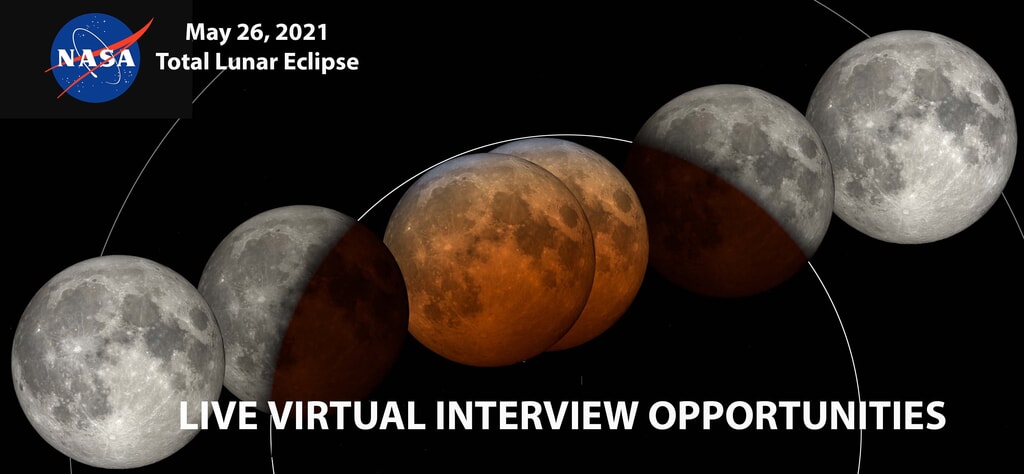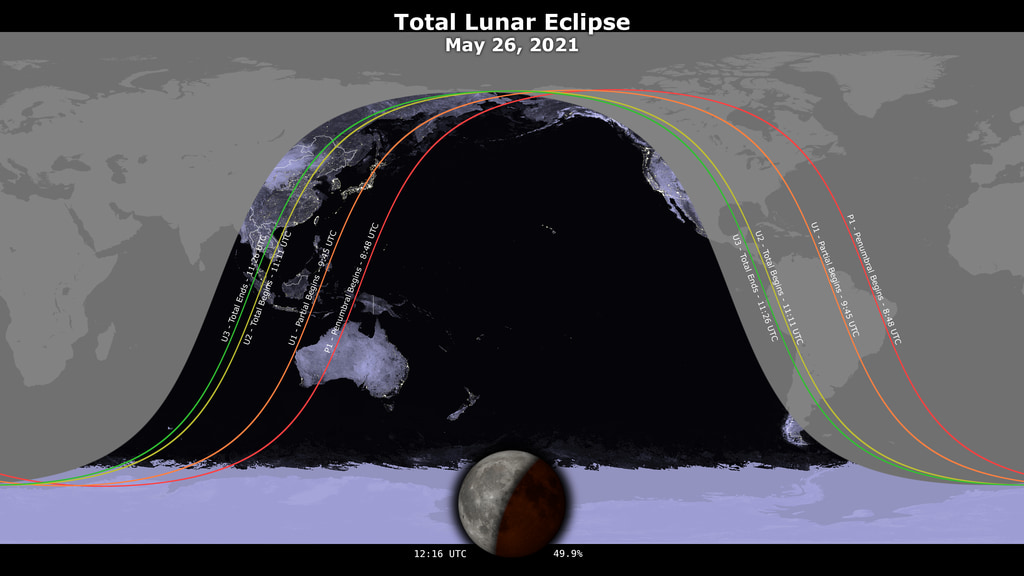May 26, 2021 Total Lunar Eclipse: Shadow View
Pacific Daylight Time (PDT). The Moon moves right to left, passing through the penumbra and umbra, leaving in its wake an eclipse diagram with the times at various stages of the eclipse.
On May 26, 2021, during early morning in the western Americas, the Moon enters the Earth's shadow, creating a total lunar eclipse, the first in almost two and a half years. This animation shows the changing appearance of the Moon as it travels into and out of the Earth's shadow, along with times at various stages. Versions of the animation have been created for both Universal Time (UTC) and Pacific Daylight Time (PDT) — within the U.S. Lower 48, those in the Pacific time zone are best situated to see the eclipse.
The penumbra is the part of the Earth’s shadow where the Sun is only partially covered by the Earth. The umbra is where the Sun is completely hidden. The Moon's appearance isn't affected much by the penumbra. The real action begins when the Moon starts to disappear as it enters the umbra at about 2:45 a.m. Pacific Daylight Time. An hour and a half later, entirely within the umbra, the Moon is a ghostly copper color. For this relatively shallow eclipse, totality lasts only 15 minutes before the Moon begins to emerge from the central shadow.
The view in these animations is geocentric. Because of parallax, the Moon's position against the background stars will look a bit different for observers at different locations on the surface of the Earth. The Moon is in the constellation Scorpius. The two bright stars in the upper right are ω1 and ω2 Scorpii.
Universal Time (UTC). The Moon moves right to left, passing through the penumbra and umbra, leaving in its wake an eclipse diagram with the times at various stages of the eclipse.

A high-resolution still image of the eclipse diagram, with times in Pacific Daylight Time (PDT).

A high-resolution still image of the eclipse diagram, with times in Universal Time (UTC).
As the Moon moves right to left, it passes through the Earth's penumbral and umbral shadow. The Download menu contains links to TIFF frames with and without the background stars. These include the composite transition between partial and total phases. It also links to the as-rendered EXR frames.
The eclipse shadow diagram animations for both Pacific and Universal time, sped up by 5X to produce a running time of 13.2 seconds.
Credits
Please give credit for this item to:
NASA's Scientific Visualization Studio
-
Visualizer
- Ernie Wright (USRA)
-
Producer
- David Ladd (USRA)
-
Scientist
- Noah Petro (NASA/GSFC)
-
Technical support
- Laurence Schuler (ADNET Systems, Inc.)
- Ian Jones (ADNET Systems, Inc.)
Release date
This page was originally published on Monday, April 26, 2021.
This page was last updated on Thursday, January 30, 2025 at 12:11 AM EST.
Datasets used
-
DEM (Digital Elevation Map) [LRO: LOLA]
ID: 653 -
DE421 (JPL DE421)
ID: 752Planetary ephemerides
This dataset can be found at: http://ssd.jpl.nasa.gov/?ephemerides#planets
See all pages that use this dataset -
LROC WAC Color Mosaic (Natural Color Hapke Normalized WAC Mosaic) [Lunar Reconnaissance Orbiter: LRO Camera]
ID: 1015This natural-color global mosaic is based on the 'Hapke normalized' mosaic from LRO's wide-angle camera. The data has been gamma corrected, white balanced, and range adjusted to more closely match human vision.
See all pages that use this dataset
Note: While we identify the data sets used on this page, we do not store any further details, nor the data sets themselves on our site.


